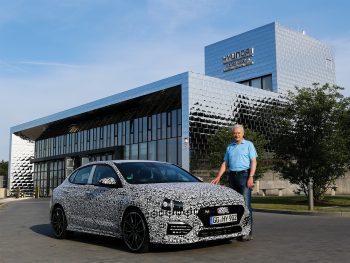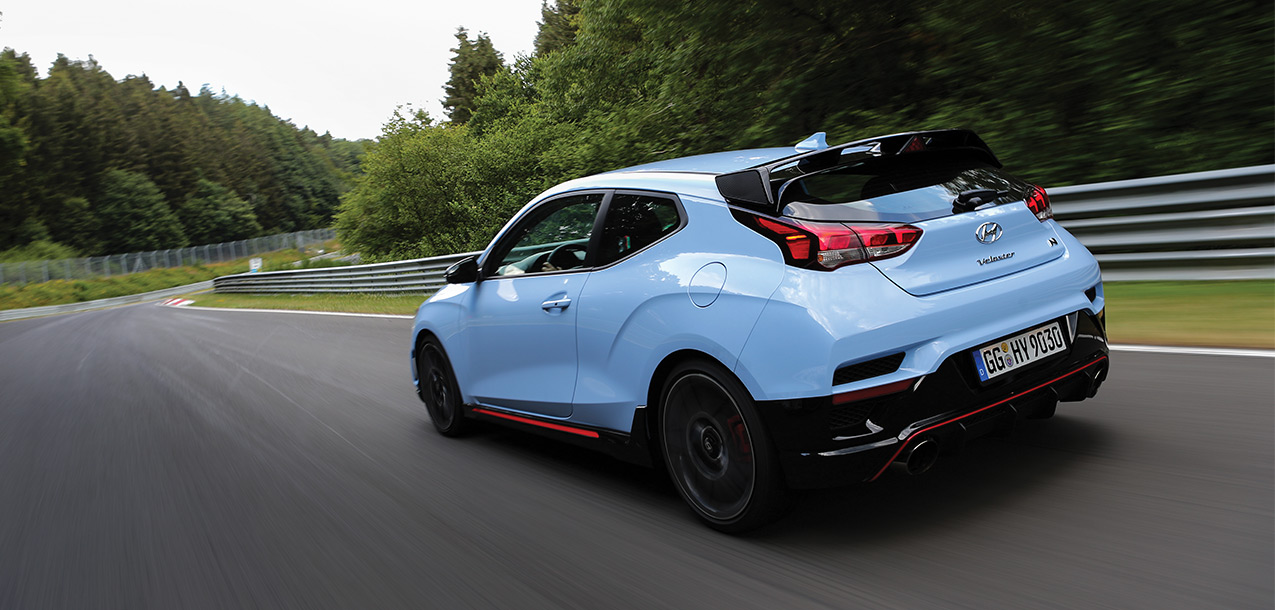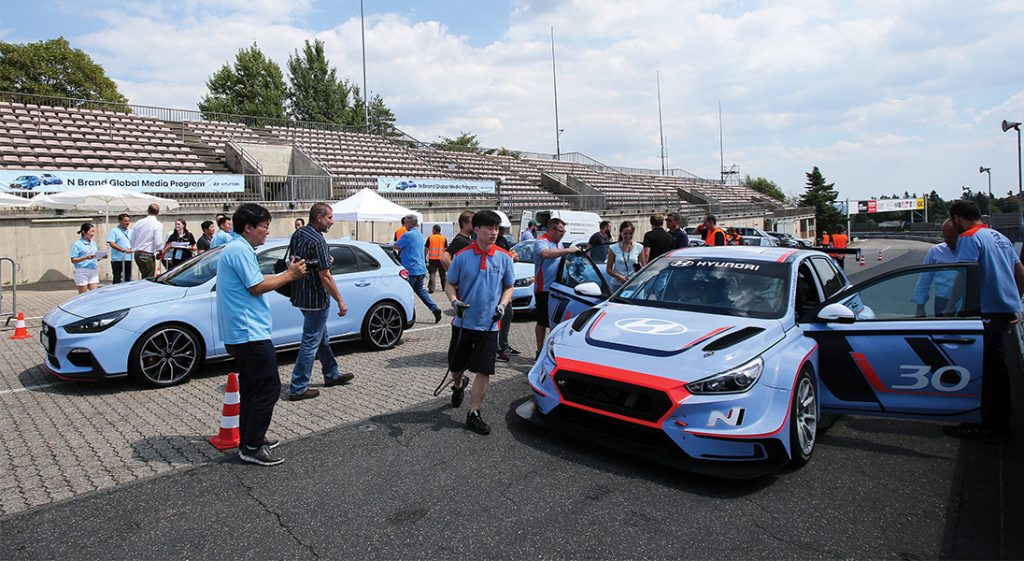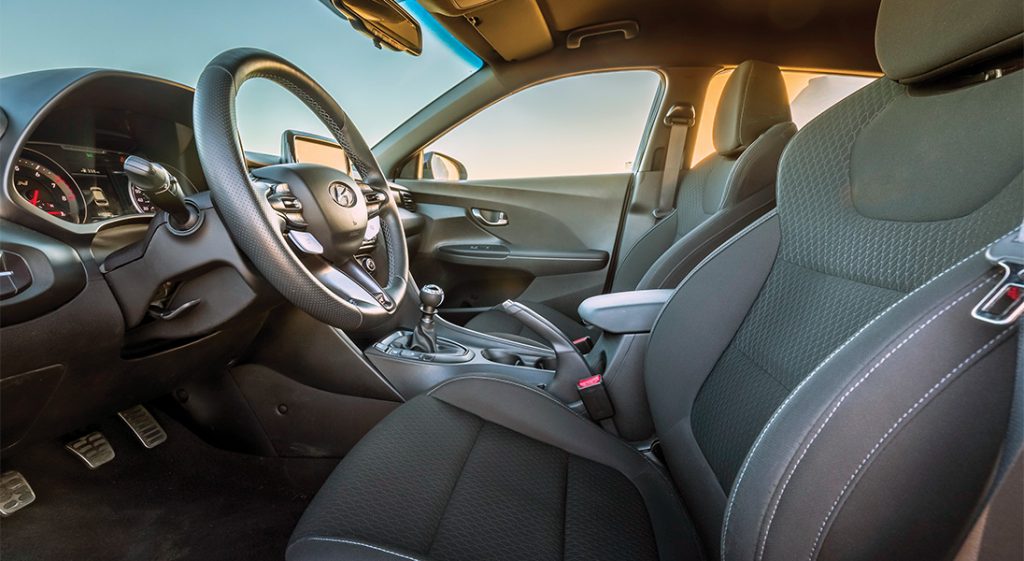Ninety years ago, Kellogg’s poured milk over a toasted rice cereal and a legend was born. Kellogg’s Rice Krispies didn’t only taste great, it also sounded great delivering a Snap, Crackle and Pop that set it aside from all other cereals. Appealing to an additional sense has kept Rice Krispies one of the most popular breakfast cereals for nearly a century. Hyundai hopes to find a similar success by appealing to additional senses with its new N-series platforms. The 2019 Veloster N literally snaps, crackles and pops as Hyundai’s first serious contender in the premium-performance compact FWD market occupied by the Focus ST, VW GTi and Civic Si and Type-R. Not only did we have a chance to drive the Veloster N on Germany’s no-speed-limit Autobahn, we also took it for a couple of laps around the Nurburgring.
Text by Michael Ferrara // Photos courtesy of Hyundai Motor America & Joe Singleton
DSPORT Issue #198
The Opportunity
 There are a group of automotive journalists that live out of suitcases attending manufacturer long leads around the world. When a new vehicle is launched or a current design is updated, an OEM hosts a press event to give key members of the media an opportunity to experience the vehicle. It’s an interesting group of individuals that produce about 90 percent of the content you’ll find in print and on the web. DSPORT rarely attends such events unless there is a new platform that would be a good fit for our audience or if the experience itself would be something our readers would enjoy. Hyundai invited us to its long-lead for the Veloster N. Admittedly, we hadn’t really done anything with the Veloster or Veloster Turbo in the past and we had no clue if a Hyundai N-series vehicle would deliver the goods. However, the opportunity to blast on the Autobahn and get out to the Nurburgring to make laps on the Nordschleife couldn’t be turned down. That experience alone would be worth sharing with our readers. As I hopped on the flight to Germany (which lost my luggage of course), I had no preconceived notion of what this Veloster N would or wouldn’t be able to deliver.
There are a group of automotive journalists that live out of suitcases attending manufacturer long leads around the world. When a new vehicle is launched or a current design is updated, an OEM hosts a press event to give key members of the media an opportunity to experience the vehicle. It’s an interesting group of individuals that produce about 90 percent of the content you’ll find in print and on the web. DSPORT rarely attends such events unless there is a new platform that would be a good fit for our audience or if the experience itself would be something our readers would enjoy. Hyundai invited us to its long-lead for the Veloster N. Admittedly, we hadn’t really done anything with the Veloster or Veloster Turbo in the past and we had no clue if a Hyundai N-series vehicle would deliver the goods. However, the opportunity to blast on the Autobahn and get out to the Nurburgring to make laps on the Nordschleife couldn’t be turned down. That experience alone would be worth sharing with our readers. As I hopped on the flight to Germany (which lost my luggage of course), I had no preconceived notion of what this Veloster N would or wouldn’t be able to deliver.
Track Time
After a day of sightseeing to get acclimated to the time difference, it was time to hit the track. We were given some morning instructions before getting the opportunity to do some lead-follow laps on the Nordschleife at Nurburgring. This 12.9-mile course features over 70 turns, elevation changes and a variety of bumps and challenging road conditions typically encountered on public roads. Hence, it’s the ultimate test track for vehicle evaluation and the reason why all of the manufacturers look to set times at “the Ring.”
Driving the Ring is a must for any performance car enthusiasts. It was simply amazing and I’ll jump at the opportunity to do it again whenever presented. During the track time, the lead car was only pushing the pace at 75-to-85-percent of what the Veloster N seemed capable of doing but that in no way diminished any of the thrill that the course and car delivered.
Veloster 2+1 Coupe
If you haven’t given that much attention to Hyundai’s Veloster, you are not very different from most of the members on the DSPORT staff. While we can tell you all about the current and past performance platforms from all of the Japanese makers, few knew that the Veloster had a 2+1 coupe design. What is a 2+1 coupe? From the driver’s side of the vehicle, the Veloster has a large driver’s door like a standard 2-door. From the passenger side of the vehicle, the Veloster looks to be a 2-door at first glance. However, after a bit of studying, a rear passenger door with a handle hidden up near the rear of the door’s window is apparent. Ultimately, the configuration delivers additional practicality. Of course, the staggered location of the C-pillars on the left and right side of the vehicle make for an interesting discussion with the fabricator when the time comes to design and fabricate a roll bar, as the main hoop cannot be lined up with the C-pillars. In Germany, we mainly traveled in groups of two and the Veloster seemed like a two-door. However, we could see the benefits of that third door when travelling with a third or fourth companion. While the chassis configuration is rather unique, the power plant is strangely familiar.
Track Handling
The Veloster N handled exceptionally well without any torque-steer or understeer issues often present in a higher-powered FWD platform. Hyundai’s N team did a tremendous job of blending the tuning of the suspension, steering and limited-slip control to deliver (I hate to say this) “the ultimate driving experience.” The active suspension does a great job of load-transfer control limiting the dive during braking or the roll during cornering. At the same time, the electric power steering system provides a great balance between steering input effort and feedback, eliminating the numbness present in many other electric power steering systems. This is all occurring as the electronically-controlled torque-vectoring limited-slip differential is determining when it’s best to open or lock the power delivery to the front wheels. Trying to control three separate systems for a common goal is no easy task. It’s the equivalent of trying to shoot a moving target from a rocking boat as the wind speed varies. Yet somehow, the Hyundai N team programmed the systems to hit a bullseye at nearly every corner.
LAUNCH MODE
Speaking of fun, Hyundai also programmed a launch mode into the Veloster N. From a stop, you simply push in the clutch, mash the throttle and let the engine come up on the two-step. Come off the clutch and the throttle, boost and ignition timing are controlled to deliver a launch with just the right amount of wheelspin. We didn’t get to play with this feature too much or know how it will do with stickier tires in place, but we love that Hyundai is thinking that a Veloster N may need to maximize its acceleration from a dead stop.
The “N” Word
So what is the meaning of the letter “N” designation? Like the “D” in DSPORT, the “N” appears to have many meanings. Its origin comes from Namyang (Hyundai’s R&D center in Korea), but the “N” now also includes Nurburgring where Hyundai has a dedicated facility to support WRC, TCR, R5 and performance R&D. All of the current and future N-series Hyundai vehicles are themed to be “Fun to Drive.” They are designed and engineered to be race-track capable, everyday sports cars that excel in handling and performance.
Power Delivery
The broad torque curve of the 275-horsepower 2.0-liter engine worked well with the six-speed close-ratio manual transmission. With the exception of the faster sections of track, Third does most of the Ring (30MPH to 90MPH) while Fourth and Fifth can be used on the faster section and long straights. I had no complaints on the shifter feel and I never missed a gear. The clutch didn’t complain and seemed to do a good job of power modulation.
Feedback on power delivery and engine speed is presented well, both visually and audibly. The center of the dash provides a progressive LED shift light that lets you know it’s time to grab the next gear. If the road is requiring all of your visual focus, the exhaust note of the Veloster N is loud enough to keep you in sync with engine speed (a true fault of the Type-R’s electric car exhaust system). Hitting the rev limiter or a rev-matched downshift delivers an addictive and intoxicating snap, crackle and pop. While there is a slight antilag performance benefit, it’s 90-percent entertainment and 10-percent function. Still, I stepped away thinking I should tune my car’s ECU to do the same. It’s simply damn fun getting into a conversation with your engine.
On track, there was never a sense that the engine is running out of steam. It pulled well up until redline. The gearing also seemed well matched as there wasn’t a gear that seemed too short or too long. It was only on the longest straights where it seemed like more than the available 275hp would be helpful.
Braking and Heat Management
The Veloster N sport package features larger brakes than standard Veloster N. The front rotors are 345mm while the rear are 315mm (standard Veloster N are 330mm/300mm). Pedal feel was firm and the initial bite and modulation was good. Over the 26 miles covered in two laps over 140 turns, there were no signs of brake fade. There were also no signs of excessive coolant temps or a drop in performance. Heat management seems extremely well controlled. Hyundai claims that the vehicle has been engineered to go through a full tank of fuel on track and this seems to be a legitimate claim. Considering the number of newer vehicles that can’t go more than a lap or two before overheating (or going into a power-reduction or limp mode), we are happy to see that the Europeans were able to convince Hyundai to put race track endurance at the top of the priorities for the design and build.
Feel the Feeling
 If the N-series vehicles sound like they are aiming to be “The Ultimate Driving Machines,” that would make perfect sense as Hyundai has acquired much of the top talent from BMW’s M-division. In 2015, Albert Biermann, the head of BMW’s M division, defected to Hyundai while this year Thomas Schemera left after 31 years at BMW to focus on taking the N division to the next level. So why would long-time successful talent leave BMW for a gamble at Hyundai? In one word: Freedom. Since there is no motorsport history at Hyundai, there are no “we’ve always done it this way” rules in place. Biermann, Schemera and the other talent that Hyundai is poaching from across Europe are being given the freedom to create, take risks and direct performance in both motorsports and enthusiast vehicles. The Hyundai teams from Asia and Europe are extremely pleased with the initial progress and are looking forward to continued success. Considering that Hyundai will likely win the driver and manufacturer championships in WRC this year, the payoffs seem to be coming early.
If the N-series vehicles sound like they are aiming to be “The Ultimate Driving Machines,” that would make perfect sense as Hyundai has acquired much of the top talent from BMW’s M-division. In 2015, Albert Biermann, the head of BMW’s M division, defected to Hyundai while this year Thomas Schemera left after 31 years at BMW to focus on taking the N division to the next level. So why would long-time successful talent leave BMW for a gamble at Hyundai? In one word: Freedom. Since there is no motorsport history at Hyundai, there are no “we’ve always done it this way” rules in place. Biermann, Schemera and the other talent that Hyundai is poaching from across Europe are being given the freedom to create, take risks and direct performance in both motorsports and enthusiast vehicles. The Hyundai teams from Asia and Europe are extremely pleased with the initial progress and are looking forward to continued success. Considering that Hyundai will likely win the driver and manufacturer championships in WRC this year, the payoffs seem to be coming early.
The Veloster N is just the beginning. There will be more N-series platforms on the horizon, a lineup N-series of performance parts and even Hyundai factory-prepped racecars. Currently, Hyundai offers both an i30N TCR class FWD racecar and an i20 NAWD R5 rally racecar.
4B11/Theta II GDI Evolution
In 2005, Chrysler, Mitsubishi and Hyundai began a joint venture for engine development. Mitsubishi’s 4B11 and Hyundai’s Theta series were two of the offspring from this venture. The engines shared many similarities with a high number of interchangeable parts. The Theta II GDI version of the engine represents the direct-injection evolution of the original Theta engine platform. In addition to direct-injection, the engine also features a two-stage intake manifold, variable valve timing on the intake camshaft and an electronically-wastegated turbocharger. For the Veloster N, the engine is rated at 250 horsepower standard or 275 horsepower with the sport package.
Street Impression
After some time at the track, we had the opportunity to take these same cars out on the streets the following day. This included some time on the world famous Autobahn and some time on various twisty forest roads. The Veloster N charged up to 150MPH on the Autobahn effortlessly. Timing the hills properly, we got the Veloster N to go over 160MPH. Cruising at these speeds also never made the coolant temperature needle budge.
While the Veloster N offers a number of driving modes that deliver additional comfort, I kept it in the N mode for the hour road experience and never felt fatigued. The active suspension worked extremely well and the seats provided a great balance of support and comfort. My only regret with the experience was not having more seat time to experience the electronics. I don’t think I even turned on the radio because I loved hearing the snap, crackle and pop of the exhaust.
Having only an hour of seat time on the street and 20 minutes on the track, I couldn’t tell you much about the interior except that the seats worked well and the layout worked well.
DYNO TESTED
We put the sport package Veloster N on our Club DSPORT Dynojet and recorded just shy of 239 horsepower to the wheels at 5,800 RPM. That’s the equivalent of 280 flywheel horsepower. The engine hits a soft rev limiter just beyond 6,700 RPM while a hard rev limit of 6,900 RPM is present. We performed our testing in Fourth gear with the vehicle cruising at about 2,200 RPM before going to wide open throttle. Full boost of 14psi was realized less than a second (and less than 500 RPM) later, demonstrating a very responsive turbocharger selection. The engine’s torque curve is very similar to the VW GTi engine with the exception being that the Veloster N engine goes well beyond the VW’s 5,500 RPM redline. The broad torque band of the engine makes ideal gear selection less of an issue so you waste less time with gear changes on many tracks. Third gear works well from 30MPH to 90MPH and Fourth is ideal between 50MPH and 120MPH.
The Bottom Line
The Veloster N is an impressive vehicle. Is it great or just good? That answer will depend on its pricing. It could be a great car at the right price. At that right price, this might be the first Hyundai I would consider owning. It does everything extremely well. The technologies are well integrated and effective. The vehicle is meant to compete against the VW GTi, Focus ST and Civic Si. If the base Veloster N can come in around the $26-$28K mark, it will be a great value. If it can be under $30K with the sport package, I think we’d see plenty of these on the road and at the track. We should know the pricing soon, so be sure to be on our Facebook and Instagram feeds. As long as the company continues to focus on performance, I expect to see more great vehicles with a Hyundai badge.
Part one. Veloster N vs Civic Type R Preview.
















